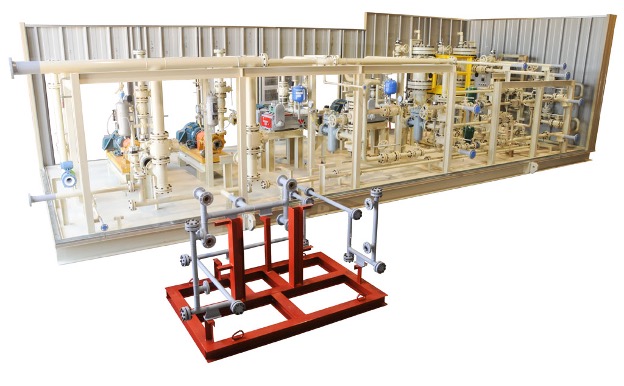
What Are Sand Separators and How Do They Work?
Sand is a nuisance. It chews through valves, erodes pipe walls, clogs separators, and just generally makes a mess of things. But sand is a part of life, especially when producing from unconsolidated formations or frac wells. That’s where a good sand separator/desander comes in. These pieces of equipment are essential to good sand management and to keeping your facility online.
What is a Sand Separator?
A sand separator (sometimes called a desander or sand trap) is a pressure vessel that removes sand and other solid particles from wellstream fluids before they reach downstream equipment. You’ll usually find it installed upstream of production separators, heater treaters, or choke manifolds. Its main job is simple: separate solids from liquids and gases so that your other equipment doesn’t wear out prematurely.
Sand separation can happen at the wellhead, on test skids, or as part of early production facilities. Some operators use them permanently, others only for cleanup flowback after a frac job. Either way, they’re the first line of defense against erosion and downtime.
Types of Sand Separators
There are a few main types of sand separators, each with its own advantages.
1. Gravity-Based Separators – These rely on gravity to let sand settle to the bottom of the vessel. They’re simple and good for lower flow rates but not ideal when you’ve got high velocities or fine particles.
2. Cyclonic/Centrifugal Separators – These are the workhorses for modern production systems. They use centrifugal force (essentially spinning the flow) to sling sand and solids outward where they drop into a collection chamber. They’re compact, efficient, and can handle a lot of sand without a lot of maintenance.
3. Filter-Type Systems – These are used when you need to polish the flow and catch finer particles that slip past the desander. They’re often downstream of the main sand separator.
Each design has its place. Cyclonic units are great for high flow rates and well cleanup. Gravity separators are good for gentle service. Filter systems finish the job. The key is knowing what kind of sand load and particle size you’re dealing with.
Two-Phase/Three-Phase Designs
In oil and gas operations, separators are often grouped into two main categories: two-phase and three-phase. Two-phase separators handle sand and liquid separation only. Three-phase separators are designed to separate sand, liquid, and gas simultaneously.
Vertical/Horizontal Configurations
Sand separators can also be configured as vertical or horizontal units. Vertical separators are often chosen when space is limited or sand load is moderate. Horizontal separators handle higher flow rates and larger volumes of sand more efficiently.
How Sand Separators Work
Here’s how a sand separator does its job, step by step:
- The multiphase flow (oil, gas, water, and sand) enters the vessel through an inlet designed to create either a spin or a change in velocity.
- Centrifugal/gravitational forces act on the stream, and the heavier sand particles fall out of suspension.
- The separated sand drops into a collection vessel, accumulator, or dump pot.
- Cleaned fluids exit the separator and continue downstream.
A few notes from experience: the inlet velocity, particle size, and pressure all matter. Too much velocity and the sand won’t fall out. Too little and you’ll end up with buildup. It’s all about finding that balance. Most desanders can remove particles down to 10 microns, but with the right design, you can get it even finer.
How Sand Separators Improve Operations
When you put a good sand separator to work, the results show up quickly. Here’s what you can expect when a sand separator is doing its job correctly:
- Less erosion on choke valves and piping
- Reduced downtime from maintenance and equipment repair
- Better separation efficiency downstream
- Longer equipment life and safer operation
- Reduced risk of environmental spills caused by sand buildup/line rupture
A good sand management program doesn’t stop at one separator. You should think of it as a system, from the wellhead all the way to the tank battery.
Where Sand Separators Are Used
Sand separators are a familiar sight across oil and gas fields. Wherever sand enters the production stream, it brings wear, pressure drops, and downtime risks along with it. You’ll find sand separators just about everywhere:
- Wellhead production facilities where formation sand is a problem.
- Test separators and early production systems during flowback and cleanup.
- EOR projects where sand migration is common.
- Offshore and onshore installations, pretty much anywhere you’ve got solids moving through a flowline.
Some operators even move mobile desanders from well to well, especially during initial production when sand loads are unpredictable.
For example, IFS supplied a desanding skid for Encana’s Solar Saturn Compressor Station at Cutbank Ridge, efficiently removing frac sand from the production stream and protecting critical process equipment. Read more here.
Discover DXP/IFS Sand Separation Solutions
DXP/IFS provides engineered sand separation and desander packages designed to remove sand from production systems efficiently and safely. Our modular, skid-mounted designs allow continuous operation and are built to handle the toughest sand loads. Every unit is tested before shipment and backed by 24/7 support.
Learn more about our Production Sand Removal Packages and full line of modular solutions at DXP/IFS.Or contact us online!

